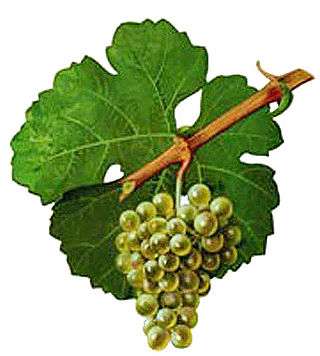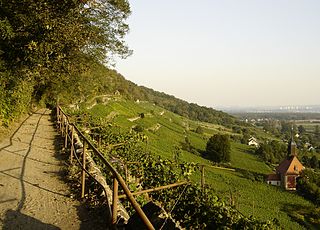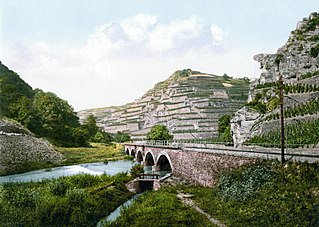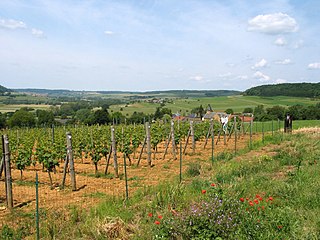
Merlot is a dark blue–colored wine grape variety that is used as both a blending grape and for varietal wines. The name Merlot is thought to be a diminutive of merle, the French name for the blackbird, probably a reference to the color of the grape. Its softness and "fleshiness," combined with its earlier ripening, make Merlot a popular grape for blending with the sterner, later-ripening Cabernet Sauvignon, which tends to be higher in tannin.

Riesling is a white grape variety that originated in the Rhine region. Riesling is an aromatic grape variety displaying flowery, almost perfumed, aromas as well as high acidity. It is used to make dry, semi-sweet, sweet, and sparkling white wines. Riesling wines are usually varietally pure and are seldom oaked. As of 2004, Riesling was estimated to be the world's 20th most grown variety at 48,700 hectares, but in terms of importance for quality wines, it is usually included in the "top three" white wine varieties together with Chardonnay and Sauvignon blanc. Riesling is a variety that is highly "terroir-expressive", meaning that the character of Riesling wines is greatly influenced by the wine's place of origin.

Mosel is one of 13 German wine regions (Weinbaugebiete) for quality wines , and takes its name from the Mosel River. Before 1 August 2007 the region was called Mosel-Saar-Ruwer, but changed to a name that was considered more consumer-friendly. The wine region is Germany's third largest in terms of production but some consider it the leading region in terms of international prestige.

Chenin blanc is a white wine grape variety from the Loire Valley of France. Its high acidity means it can be used to make varieties from sparkling wines to well-balanced dessert wines, although it can produce very bland, neutral wines if the vine's natural vigor is not controlled. Outside the Loire, it is found in most of the New World wine regions; it is the most widely planted variety in South Africa, where it was historically also known as Steen. The grape may have been one of the first to be grown in South Africa by Jan van Riebeeck in 1655, or it may have come to that country with Huguenots fleeing France after the revocation of the Edict of Nantes in 1685. Chenin blanc was often misidentified in Australia, as well, so tracing its early history in the country is not easy. It may have been introduced in James Busby's collection of 1832, but C. Waterhouse was growing Steen at Highercombe in Houghton, South Australia, by 1862.

German wine is primarily produced in the west of Germany, along the river Rhine and its tributaries, with the oldest plantations going back to the Roman era. Approximately 60 percent of German wine is produced in the state of Rhineland-Palatinate, where 6 of the 13 regions (Anbaugebiete) for quality wine are situated. Germany has about 103,000 hectares of vineyard, which is around one tenth of the vineyard surface in Spain, France or Italy. The total wine production is usually around 10 million hectoliters annually, corresponding to 1.3 billion bottles, which places Germany as the eighth-largest wine-producing country in the world. White wine accounts for almost two thirds of the total production.

Müller-Thurgau is a white grape variety which was created by Hermann Müller from the Swiss Canton of Thurgau in 1882 at the Geisenheim Grape Breeding Institute in Germany. It is a crossing of Riesling with Madeleine Royale. It is used to make white wine in Germany, Austria, Northern Italy, Hungary, England, Australia, the Czech Republic, Slovakia, Slovenia, New Zealand, Canada, the United States, Belgium and Japan. There are around 22,201 hectares ) cultivated worldwide, which makes Müller-Thurgau the most widely planted of the so-called "new breeds" of grape varieties created since the late 19th century. Although plantings have decreased significantly since the 1980s, as of 2019 it was still Germany's second most planted variety at 11,400 hectares and 11.4% of the total vineyard surface. In 2007, the 125th anniversary was celebrated at the Geisenheim Grape Breeding Institute. Müller-Thurgau is also known as Rivaner, Riesling x Sylvaner, Riesling-Sylvaner, Rizvanec (Slovenia) and Rizlingszilváni (Hungary).

Silvaner or Sylvaner is a variety of white wine grape grown primarily in Alsace and Germany, where its official name is Grüner Silvaner. While the Alsatian versions have primarily been considered simpler wines, it was included among the varieties that can be used to produce Alsace Grand Cru wine in 2006, together with the four 'noble grapes' of Alsace, although only in one vineyard, Zotzenberg.

Werder (Havel) (official name derived from Werder an der Havel ("Werder upon Havel"), colloquially just Werder) is a town in the state of Brandenburg, Germany, located on the Havel river in the Potsdam-Mittelmark district, west of the state's capital Potsdam.

Moselle wine is produced in three countries along the river Moselle: France, Luxembourg and Germany. Moselle wines are mainly white and are made in some of the coldest climates used for commercial winemaking.

Franconia is a German wine region, mostly in north west Franconia. It is the only wine region in the federal state of Bavaria. In 2014, vines were grown on 6,176 hectares of land in the region.

Saxony (Sachsen) is a region for quality wine in Germany located in the German federal state of Saxony. The region is sometimes referred to colloquially as the Elbtal. The wine region covers 462 hectares, which makes it Germany's third smallest region, just ahead of Mittelrhein and Hessische Bergstraße in size. It is situated along the Elbe river from the Pillnitz section of Dresden to the village of Diesbar-Seußlitz located north of Meissen. Together with the Saale-Unstrut wine region, Saxony is one of the northernmost wine regions in Europe and are the only two of Germany's 13 wine regions that are located in the former East Germany. After German reunification in 1990, the vineyard surface was expanded from 200 to 450 hectares with European Union subsidies, but in recent years the vineyard area has decreased.

Baden is a region (Anbaugebiet) for quality wine in Germany, and is located in the historical region of Baden in southwestern Germany, which today forms part of the federal state of Baden-Württemberg. Under German wine legislation, Baden and Württemberg are separate wine regions.

Württemberg is a region (Anbaugebiet) for quality wine in Germany, and is located in the historical region of Württemberg in southwestern Germany, which today forms part of the federal state of Baden-Württemberg. Under German wine legislation, Württemberg and Baden are separate wine regions.

Nahe is a region (Anbaugebiet) for quality wine in Germany, along the River Nahe in the state of Rhineland-Palatinate. On the region's 4,155 hectares of vineyards in 2008, white wine grapes dominate with 75% and Riesling is the most common variety with 27.2%. A characteristic of the Nahe region is that the soils are very varied owing to the region's volcanic origins.

Ahr is a wine region (Anbaugebiet) for quality wine in Germany, and is located in the valley of the river Ahr, a tributary of Rhine, and is situated in the federal state of Rhineland-Palatinate. With only 558 hectares of vines as of 2008, it is one of smaller of Germany's 13 regions. Despite its northern location it primarily produces red wines, and red grape varieties account for 86% of the vineyard area, which is more than in any other German wine region.
Mittelrhein is a region (Anbaugebiet) for quality wine in Germany, and is located along a 120 km stretch of river Rhine in the tourist portions of the Rhine region known as Middle Rhine. On the left bank of Rhine, vineyards begin immediately downstream of the Nahe estuary and last until Koblenz. On the right bank, vineyards begin where Rheingau ends and last until 8 kilometers south of Bonn, in the Siebengebirge. Parts of the Rhine Gorge, a UNESCO World Heritage since 2002, make up the southern part of Mittelrhein.

Stargarder Land is a small region for country wine in northeastern Germany, which was defined in an amendment to the German wine law on 4 March 2004. Located in Mecklenburg-Vorpommern, approximately 100 km north of Berlin, it is by far the northernmost official wine-growing area of Germany. The designation Mecklenburger Landwein is used for country wines from this region.

Belgian wine is produced in several parts of Belgium and production, although still modest at 1,400 hectoliters in 2004, has expanded in recent decades.

Swedish wine, in terms of wine produced commercially from grapes grown in Sweden, is a very marginal but growing industry which saw its first beginnings in the late 1990s.

The Werderaner Wachtelberg is a 6.2 hectares vineyard in the town of Werder (Havel) in Brandenburg. As the northernmost outpost of the Saale-Unstrut wine region, it is the most northern registered location for QbA quality wine in Germany.



















